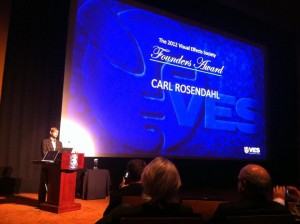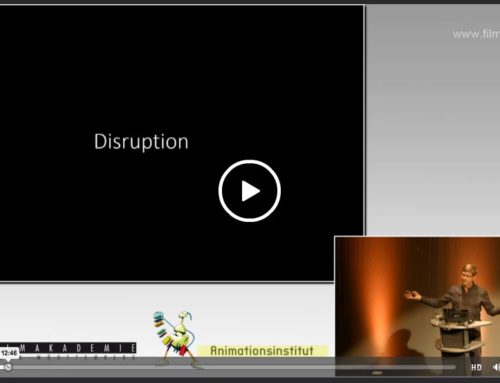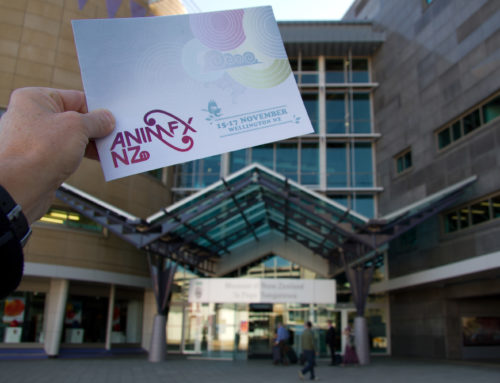I am privileged to be a part of an industry and company that helped change the world. When I started PDI in 1980, I joined a small community of people who believed that we could make something that was impossible to do at the time – that someday computers could be used to create images to tell stories on TV and in the movies. We knew it would take a long time, maybe 15 or 20 years to do.
We caused a fundamental shift in the way films are made and the types of stories that can be told. We did this with a passion for inventing, for building and wrestling with the technology until we could conform it to our will.
I’ve also had the unique opportunity to have had three different careers around this dream:
– As an entrepreneur helping to create and build an industry
– As a venture capitalist investing in entertainment technologies
– And now as a professor mentoring the next generation of creative talent
So it’s disheartening to me to see the industry I love so much behave like it’s dying, when in fact it is just being born.
I wish I was 23 again!
To understand my frustration, let’s take a quick trip through time, starting in the early 1800s, and look at what our options for entertainment are.
It’s 1820; we can read, socialize, play games and music, and dance with each other. We can create and enjoy art – paintings, drawings, sculptures. We can go out to hear live music, including classical orchestras with 35 musicians.
Photography is invented in the late 1830s, and by the mid-1840s becomes a popular way to record images of ourselves, our environments and our daily lives – dealing a blow to painters, who react by exploring their medium in new, more interesting ways.
Orchestras continue to be popular, and composers start to make them bigger, swelling to twice their former size – a trend that lures bigger audiences and creates larger concert halls.
In about 1878 both the phonograph and moving pictures are invented, and by the late 1890s they start to vie for people’s attention listening to music at home and watching Kinetoscopes in penny arcades.
Perhaps not coincidentally, composers like Wagner and Stravinsky expand the size of orchestras to almost 100 members, creating huge, loud, exhilarating experiences to attract their audiences.
In 1906 the first radio program is broadcast, ushering in a new era of live entertainment delivered directly into the house, followed closely by the birth of Hollywood, enabling the motion picture industry to thrive.
And orchestras get bigger. By the mid-1920s they hit their peak size of 110 to 120 members.
Then, in 1927, The Jazz Singer is released – the Talkies are born, and the role of the orchestra changes forever.
But the movies haven’t won. A year later, in 1928, Philo Farnsworth invents the television and the war for the moving picture audience begins. Movies add color. TVs add color. Movies get bigger. TVs get bigger. Movies add surround sound. TVs add surround sound. Movies get even bigger. TVs get even bigger. They both go 3D. Movies go onto TV. TV goes to the movie theater. Movies add a higher frame rate. TV already has it.
Our orchestras in the meantime have stagnated. Their traditional performances are funded as much by charity events as they are by ticket sales. The musicians spend much of their careers performing music that is the score behind the motion pictures made by the industry that sidelined them. But that isn’t to say that those changes were bad for music. Those same broadcasting and recording technologies created a new music industry that gave birth to jazz, rock and roll, and down tempo trip hop techno pop.
Today, you’re the musicians in that orchestra in the 1920s. There are big changes happening that you can ignore or take advantage of.
The only issues I hear about are outsourcing, tax incentives, global competition, unfair business practices, runaway production, trade organizations, unions, ownership, piracy, the race to the bottom.
It’s really important stuff; I understand that, I’ve run a business.
There is no solution, only opportunities.
If you think a trade organization will solve your problems, then get off your ass and make one. Start small, pick an easy problem and fix it. Grow from there to bigger, harder problems.
A “level playing field” won’t solve all the problems. You can’t legislate or otherwise keep people from willingly losing money.
Getting participation won’t be free. You have to put skin in the game, and in Hollywood’s case, skin is cash.
Globalization: It’s here to stay, deal with it.
Diversification gives you a broader base of business. You can invest in change that way without even having to go all in.
There isn’t enough movie work to go around. It’s simple supply and demand. You can’t limit the supply of companies willing to do the work; in fact it’s still growing. You need to create demand for something that you can do better than anyone else. And not just better, but you need to be unique.
The only way you’re going to convince your customers that you’re not a commodity is by being able to offer them something no one else can. If you’re offering the same product with the same terms, then as far as they’re concerned you are a commodity. You have to be different to compete.
Digital Domain has been a voyeur’s delight, but don’t get too distracted by it. There is only one lesson to learn there, and it’s a general life lesson not a VFX lesson: don’t spend money you don’t have. DD is not a specific indicator of anything wrong in this industry other than that company’s bad management. We saw this happen before in 1987 with Omnibus – they went public on the Canadian stock exchange, then gobbled up two other companies that were struggling, with the hope that even though they were losing money they’d make it up in volume somehow. That also lasted less than a year. But great companies like R&H rose up out of those ashes and did it right.
DD’s strategic thinking wasn’t necessarily wrong, but its implementation was crazy. Ender’s Game might have worked. Tembo might have worked. An animation school might have worked. Doing military contracts might have worked. But they only had the resources to pursue one of those things.
My recommendation: If you weren’t at DD, then don’t waste any more of your time on fretting about DD. Move on and dedicate your precious brain cycles to making things better for you.
And don’t spend money you don’t have.
So maybe you think you’ve fixed it. It seems there’s a level playing field, and while competition may be stiff, at least nobody feels like they’re getting screwed. The death of our industry has been averted, or at least postponed.
But let’s go back to our history field trip. It’s the late 1960’s and life is good.
While the movies and TV are duking it out, groups of researchers under a government contract are figuring out how to network computers together, and in 1969 Southern California and Northern California talk over the ARPANET for the first time. Jump forward a bit to 1995, the year the DVD is introduced, and the Internet is set free upon the world, becoming officially commercialized.
So now again, we find ourselves in 2012. Our options for entertainment and idle time amusement seem endless. The music we used to have to go to the concert hall to hear came directly into our houses with the advent of radio. The transistor radio made that portable, and the Walkman allowed us to select our music while on the move. Now because of the Internet we can choose from millions of songs and have them streamed instantly to us anywhere, anytime in glorious high fidelity. That’s happened with video, movies, and even with our old friend the book.
Now, we can read or socialize. We can create, share and enjoy music, photos, videos, television and movies. We can play games alone, we can play games with friends, or we can play in a clan against 1000s of other people. We can blog, tweet, follow, unfollow, friend and unfriend. Anytime, anywhere. That’s a lot of competition for our free time.
It astonishes me that people keep going to the movies at all. But they do because the experience keeps getting bigger and more extreme – which it must do to compete with all our other activities. Movies have to give us magic we can’t experience in any other way. And that’s what visual effects do, and why every major film depends so heavily on what we do. They have to. Go big or go home; or go mobile.
But I don’t believe that’s sustainable. All those other options will catch up. High end game experiences are becoming cinematic and letting us into the action. The march of technology will create dozens of more options for the audience. Inputs won’t be limited to mice, keyboards and touchscreens – gestures will be common place along with advanced biometrics. And that high end experience is going to go mobile with higher resolution and better displays that eventually will beam directly onto our retinas without the need for a screen. Seriously.
Entertainment will become integrated even more tightly into our lives. But not as movies.
That’s called “disruption.”
Right now you’re still the musicians in that orchestra in the 1920s. There are big changes happening that you can ignore or take advantage of. But this time, you’re sitting on the technology and creative skills that will help define the entertainment experience for the next century.
And still, the only issues I hear about are the same ones: outsourcing, tax incentives, global competition, etc.
Twenty years from now it does not matter. At all. Because twenty years from now the business that you’re in today isn’t going to be relevant. If you don’t change and figure out what your new business is, then you will be sidelined.
So here is my frustration: Where is that vision? Who’s looking ahead and talking about what they’ll be doing in the future that’s impossible today?
I care about that future.
My students do, too. And they are your current audience; they are your employees; and they are your future competitors. They have a big vision for their future, and they will make it happen.
My students are from the United States, Canada, Venezuela, Columbia, France, Spain, South Korea, Singapore, India, and China. That’s this semester. If you’re xenophobic, or are a protectionist about your community, state, country, continent, or hemisphere, you can learn something from them. They’re smart, they embrace their multi-cultural experiences, and they work together easily despite the seven (or more) native languages they speak.
And here’s an interesting irony: like you, they all believe they need to leave their native countries to find work. But they want to come to California because that’s where the opportunities are.
Your business concerns are irrelevant to them. They want to follow someone with a great vision or they want to be entrepreneurs themselves.
They are thinking young. They have time to pursue their dreams. They are looking far into the future.
What about you? What’s your vision? What impossible problems are you trying to solve?
Are you going to be just a member of the orchestra playing the same old song, or are you going to stand up and be a part of the future of this industry?
Thank you.





[…] transcript from the ves awards and the speech from Carl Rosendahl, founder of pdi. http://www.anirama.com/blog/2012/09/ves-founders-award-transcript/ Here’s the full list of VES honours throughout the years Lifetime Achievement […]
Thank you Carl. This is terrific.
Good stuff!